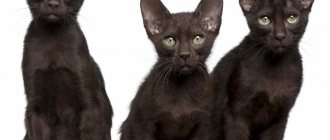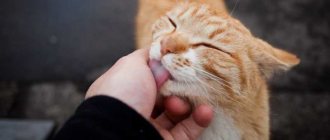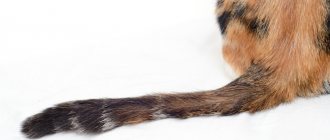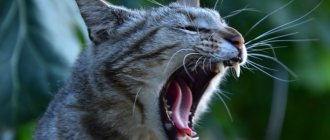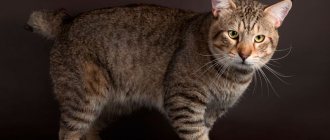Some cats live without tails
Cats lack a tail for two reasons: after injury or due to the characteristics of the breed. If a cat has lost its tail due to injury, then at first it will be uncomfortable and unusual for it to move. Gradually, the cat gets used to living without a tail: the cat’s coordination and movement return to normal.
Some cats lack a tail - a feature of the breed. These breeds include Japanese, Kuril and American bobtails, as well as Manx. These breeds live well without a tail. Nature has endowed them with a strong body and muscular hind legs.
Functions of a cat's tail
After we look at what a cat's tail is, we will better understand why it is so important in the cat world. After this, you will look differently at how your pet plays with its tail, making funny movements. And even if the cat is already an adult, he still cannot cope with his body without a tail.
- Tail for a successful hunt. One of the main functions of a cat's tail is to conduct excellent hunting. And helping the cat become an ideal predator who can do anything. So, a cat is able to prove itself on the hunt primarily thanks to its tail. After all, then the cat can jump on any fence or cornice. The tail allows you to control the body, turning where it is needed, without wasting unnecessary movements and time. The tail allows the cat to become a hunter who does not know defeat;
- Tail as a way to communicate. Having a tail not only helps you control your own body. This is a way of communication that you can trust with everything. You just need to take a closer look and you will understand how much the tail helps animals find contact. There is no better way to help cats find each other. Have you noticed different movements that allow a cat to share its mood? This can be a “pipe” tail, when the pet expresses joy in cat language. If the tail is fluffed up, then it is better not to approach the cat, it is unhappy;
- Entertainment. You may notice that when a cat is in a good mood, it shows it on its tail. There is also such an important event as creating comfort and microclimate around the pet. When the heat is intense, the cat is able to fan itself with its tail, cooling itself with its own body. But when it’s cold, the cat curls up, tucks its tail and conserves heat. Cats, if they get bored, can play with their tail, which can often be noticed. Especially if this animal is a kitten;
- Beauty is in the tail. The cat is an animal that is not alien to the feeling of beauty. And only one tail can emphasize beauty. If the tail is in order, then the pet will be satisfied with the fur and the rest of the body. It is not surprising that sometimes a cat devotes a lot of time to the tail, which really needs a lot of attention. And no matter what breed the cat is, in the cat world, any of them is rightfully considered a beauty. The main thing is that your pet feels that you love him and are ready to take care of him in order to make him even better.
No matter how you look at it, first of all, a cat needs a tail to control its own body, which often needs a hint to make the necessary movements. Again, this applies to all the points that were and will be important to these animals.
For cats, everything they have is important. We know what wool means to them, that it depends on the breed, which can be quickly guessed. But when it comes to the tail, this is especially important for a cat. This is something so important that it cannot be ignored by the animal and its owner. And this is important for all cats, no matter what breed they are.
The tail has a separate tongue
A cat's tail has 9 basic positions:
- the tail is tousled and lowered - the cat is scared;
- raised tail - greeting, joy of meeting;
- a drooping playful tail means the cat is in a bad mood. It's better to leave him alone;
- a raised tail with a curved tip - the cat is happy and wants to be friends;
- a raised slightly vibrating tail - the cat is excited and happy to see you;
- the tail is pressed to the bottom - a feeling of fear or guilt. Apparently the cat was acting up;
- the tail is raised and ruffled - strong excitement or a feeling of threat;
- the tail is curved along the body - the cat is in love.
Check out our infographic to understand exactly the language of a cat's tail.
Love your cats and take care of their tails!
Did you like the article? Share with your friends!
Possible problems with the tail
The first thing that catches our eye when we look at a cat's tail is its shape. The tail may be obviously irregular in shape. The vertebrae of a deformed tail may protrude on top of each other, forming a “ladder.” When there are kinks, the vertebrae fold into a “ladder up,” and when there are fractures, they fold into a “ladder down.” Vertebrae with these types of deformities may have rounded edges, but they are all different sizes.
The most common form of tail deformation is a bend. One or two vertebrae can stand out from the conventional “line” of vertebrae, forming a certain angle. With such a deformation, not only the tail looks unusual, but also the deformed vertebrae themselves (the vertebral body may be irregular, asymmetrical or wedge-shaped).
One of the vertebrae is deformed and forms an obtuse bend angle
Sometimes two or three vertebrae fuse together and form a knot, this type of deformity is called knotting.
Tail fractures
Such tail defects may not bother the animal, unlike fractures. The bone marrow ends in the lumbar spine, but the nerves reach the very tip of the tail. This structure of the nervous system is called the “cauda equina.” When the tail is fractured, swelling appears, displaced bones can injure nearby muscles and tendons, so fractures are accompanied by pain. A fracture can be diagnosed using an x-ray. It is noticeable when you feel all the vertebrae in the tail, but the owner can harm his pet, so if you suspect a fracture, it is better to consult a veterinarian. If the fracture is not recognized in time and the cat is not treated, the vertebrae may not heal properly. This may not affect the cat’s health, but it will cause some discomfort.
My cat’s tail was also broken in the first year of his life - the dog bit him and fell from the fence.
Also, when you stroke it, it twitches - the veterinarian said that the nerve endings are broken somewhere, but there is nothing terrible for health. The only thing this has affected is his coordination of movements and orientation in space: he does not feel the edges of the places where he lies - he falls from the bed, chairs, etc., sometimes he misses when jumping somewhere, sometimes he “calculates” incorrectly. » their movements and falls from all elevated or uneven places. In principle, we have already gotten used to it and are trying to back him up - he is very active and nimble. Recently I broke my tail again. If the tail is broken at the very base, there are no options - just watch and observe. And if it’s in the middle or at the end, the veterinarian suggests amputation. But why is this necessary if it doesn’t bother the cat - it’s just an extra injury. Scarlet https://forums.zooclub.ru/showthread.php?t=3741
Itching and scratching of the tail
In addition to fractures and bruises, cats may have other tail-related ailments. Most often these are problems with the skin and coat. Of course, any animal whose body is covered with hair can shed periodically; this is a normal phenomenon. The longer and thicker the animal's fur, the more hair falls out during the molting period. Of greater concern is hair loss due to cat behavior. If the cat is nervous, combs its tail, chews out fur, etc., then you need to determine the reason for this behavior.
Cats may bite and scratch their tail so hard that they create sores that become itchy, causing the scratching to occur again.
Parasites
Most often, scratching, gnawing fur and other behavioral reactions occur due to the appearance of parasites. Cats can be attacked by fleas, ticks, lice eaters, etc. You can “pick up” parasites on the street (for example, while walking), in the basement or from other animals. If a cat begins to “tear” its tail, you should carefully examine it; insects may leave “evidence” on the fur in the form of small black dots. Field ticks are visible to the naked eye (you need to part the fur near the bitten area).
First, fleas settle on the animal's neck, where the cat cannot reach. Gradually they populate the entire surface of the body. If a cat frantically chews hair out of its tail, the cause may be adult, old fleas. It's difficult to get them out.
To prevent such diseases, you can purchase a special collar or drops. In addition, you need to observe hygiene standards and take care of your cat's fur. If it was not possible to protect your pet from parasites, you can contact a veterinarian: in addition to anti-flea agents, antiseptics may also be required. Wounds need to be treated (for example, with Streptocide or Syntomycin ointment). It is dangerous to burn wounds with brilliant green: the edges of the sore may heal, which will again lead to scratching. If the cat is not treated, wounds may appear along the entire length of the tail, and systematic “tearing” of the skin will lead to the appearance of ulcers. If the ulcers reach the root of the tail, the skeletal system may also be affected.
Fungal diseases
However, in addition to parasites, fungal diseases can also cause itching. Ringworm is very dangerous and if it is detected, treatment should be started immediately. Mycosis can be recognized by bald spots and light spots on the skin. It may seem like it's just a “comb” covered in dandruff.
The most common fungal disease in cats is ringworm.
Ringworm is a very contagious disease that can be transmitted to humans. Cats become infected from other animals, so professional cat breeders release newly acquired animals into the “quarantine zone.”
To prevent a cat suffering from lichen from tormenting itself with “tearing”, you can buy a special device in the form of a suppressed cone with a wide base, which is called an Elizabethan collar. It limits the mobility of the head, so the cat cannot reach the itchy areas.
The protective collar immobilizes the cat's head so that it cannot reach the tail.
You can treat lichen with special antifungal agents, which are available in any pet pharmacy. General supportive medications (vitamins) are also needed. When visiting a veterinarian, an infected cat may be given an injection.
Today at the doctor's appointment they shone ultraviolet light on my face and stomach.
There is no light on the face, everything on the belly is green. The diagnosis is ringworm. They gave me a Vakderm injection (they said it was possible from 1 month). At home - Antilichen or Stop lichen (10 days), + Trivit vitamins 1 month. After 10 days, repeat Vakderm. Chicony https://forum.bolen-kot.net.ru/index.php?showtopic=17179
Allergy
Another, but no less important problem is allergies. The reaction may occur due to contact with an allergen contained in cat litter, a plastic toy, food, etc. Allergens may also be contained in inexpensive food. If there is an allergy, the cat may scratch its body and tail (sometimes the itching leads to chewing out the fur). Redness (spots) and peeling may appear in some areas of the skin. A veterinarian can prescribe proper treatment for allergies (steroids and ointments for wound healing). In addition, it is necessary to limit the animal’s contact with the irritant.
My cat is 9 years old.
Weight 3 kg. Half Persian Diagnosis: food allergy. For the last year I lived on Proplan. Everything was fine. March-April switched to cat chow. It peeled off a lot and started to itch. Since the beginning of May we have returned to ProPlan. Hair loss and itching continue. The belly and hind legs are completely bare, the tail has become like that of a sphinx, and the ears are burning with a scarlet flame. True, the neck and front legs are in excellent condition. The doctor advised to switch to natural food, and one that was not used in feed. I cook oatmeal + a spoonful of vegetables + lamb. koshkaAdel https://mauforum.ru/viewtopic.php?t=12976
Could the condition of the tail indicate health problems in a cat?
The cat's tail expresses any dissatisfaction, even if it arose due to poor health. So, a usually calm tail, if it suddenly twitches sharply, can signal that the animal is in pain. If your pet walks with his tail raised, tip twitching, and his hind legs slightly splayed, he may have kidney stones (urolithiasis). Males are susceptible to this disease. It is accompanied by pain when urinating, so when visiting the toilet the cat will meow pitifully and “twitch” its tail. The cause of urolithiasis is an improper, unbalanced diet.
You can tell that a cat is sick by its behavior and external signs.
For example, if a cat eats mostly dry food and sometimes fish, then the body may not have enough calcium. If you feed your pet only milk, there will be plenty of calcium, but there will be a deficiency of phosphorus. Due to such disturbances in the balance of the diet, stones form in the cat.
In order to promptly detect a pet’s illness, you need to know the basic parameters of the cat’s body. The body temperature of a healthy cat is from 37.5 to 39 ° C (the younger the cat, the hotter it is). The respiratory rate also depends on age: the norm for adults is 17-23 breaths per minute, for young cats - 22-24, for kittens - up to 60. The pulse of a healthy cat is up to 130 beats per minute.
For a cat, the norm is a vertical tail position (tube tail). A cat with such a tail feels good and is happy with everything. If the tail is limp, like the cat itself, it may be sick. The most serious diseases of cats are some viral diseases and oncology. It is difficult to identify such diseases; you need to consult a specialist.
Some people get scared when they notice a cat “eating” its tail. Take a closer look, perhaps the animal is simply sucking on it. This happens if a kitten is separated from its mother early. Such animals retain the need to “suck.” The cat can choose any fluffy rag (sweater, blanket, soft toy, etc.) or its own tail as an object. To prevent the cat from swallowing the thread or lint, you can try to take the toy away from it. But as a rule, by 1.5–2 years this need disappears on its own.
Video: a cat “sucks” its tail
beauty
Why does a cat need a tail? And for beauty too. There is hardly a person who will say that cats are not graceful and do not impress with their beauty. It is this attribute that is part of the animal’s appearance – fluffy, long.
The pet attracts special attention when it sits with its tail wrapped around its paws. It is impossible to pass by such a picture. For example, the online publication The Huffington Post turned out to be partial to the beauty of cats. In 2016, it published an article showcasing the beauty of a British Longhair cat named Smoothie. The article describes all the advantages of a pet, among them special attention is paid to the ideal tail.
And yet why is it needed?
The importance of a tail for a cat as a hunter living in the wild is difficult to overestimate.
This organ is used by the beast in completely different ways, depending on the circumstances and situation. It is well known that by looking at a cat's tail, you can easily understand what state of mind its owner is in, what is on his mind and what actions he intends to take in the near future. That is, this part of the body is considered as an indicator of mood. But it turns out that these are not all functions. When fighting for territory, a female, or something else, cats often sort things out using sounds and their own bodies, including their tail. It doesn't often come to a real fight. As a rule, the one with the steepest arched back or bushiest tail wins.
The tail also allows the animal to navigate in space at night (in conjunction with the mustache) and balance while jumping, climbing trees or fences.
Anurans
"The Origins of Taillessness"
In fact, most domestic tailless cats have a small stump, explains Dr. Robinson, "and a huge number of them lose their tail due to injury." When a cat loses its tail (most often as a result of an accident), the problem boils down to cutting off the blood supply. As a rule, the blood supply and nerve endings are disrupted at the fracture point - it is at this point that the amputation of the damaged tail occurs.
There is no doubt that the completely tailless cats of the Isle of Man have no reason to worry about the loss of their long appendage. There are two stories told on the Isle of Man that explain why the native cats lost their tails: the first is in the chapter on the Manx cat (in the section on breeds), and the other is that Irish warriors used to decorate their helmets with cat tails. Mother cats, fearing that their kittens would be killed for this reason, bit off their tails immediately after birth!
And one more legend: a cat from the Isle of Man is the result of love affairs between a cat and a rabbit. Of course, all this is very funny, but in fact, taillessness is purely genetic.
What do scientists think?
Dr. Michael Fox, one of the leading scientists in the field of animal behavior, argues that taillessness is a mutation bordering on death, since some kittens born do not survive. A stable mutation persists even when such animals are mated with cats that have tails. Not all cats from the Isle of Man are tailless; there are animals with quite large stumps, and some even have a real tail (read about this in the section on breeds).
How do tailless cats communicate without a tail? Susan Nuffer, chairwoman of the Morris Animal Foundation of California and an amateur breeder of Isle of Man cats (she has 10 of them and one Cymric cat), says this: “My favorite Isle of Man cats think with their heads, not their tails!” According to S. Naffer, we communicate well and express ourselves without a tail. What's worse than her cats?! She explains with conviction that Isle of Man cats don't worry about things they never needed to do. “The tail is just an appendage, they don’t care.”
Health indicator
The condition of the coat can explain a lot about your pet’s health and tell you what illnesses it may have. With a lack of vitamins and nutrients, hair begins to fall out at the very base. In this case, it is necessary to normalize the animal’s diet. A sufficient amount of microelements and vitamins must be supplied to his body.
When the fur falls out along its entire length, the cat may have a fungus, allergies, lichen or lice. If you start to go bald, there may be digestive problems, eczema or dermatitis. Under severe stress, hair can also fall out.
Important! The appearance of the first signs of health problems is an important reason to seek qualified help from a specialist. All types of therapy and processing should only be carried out by a veterinarian.
And the fan and the blanket
Besides balancing and communication, there are other (less remarkable) uses for a cat's own tail. In the summer heat, for example, you can see how the animal, stretched out in the shade, gently swings it over its own body. Thus, the cat tries to cool itself by moving air currents and creating a semblance of wind (based on the principle of a fan).
If the room is cold, the animal curls up into a ball, trying to minimize heat transfer. In this case, the tail often wraps around the body and covers the muzzle. It turns out that the animal uses the warmth of its own fur like a blanket, covering frozen areas (nose, paws).
It turns out that there is no clear answer to the question “why does a cat need a tail?” This is not just a beautiful, but also an extremely important organ, serving as a means of communication and a balancer, a fan and a blanket, and sometimes even a toy for the young. Knowing exactly how the animal uses it, and understanding what it wants to say with this or that movement, the owner can significantly improve their relationship with the pet.
Interesting facts about tailed animals
Kitties have the ability to bring comfort to the home, but they are also able to heal the inhabitants of the house, calming their nervous system with their purring. They sleep for two thirds of their lives.
Other interesting facts are known:
- The largest cat in the world is the liger, growing up to 4 m and weighing up to 300 kg, and the smallest is about 0.5 m and 1 kg.
- The Turkish Van breed has a waterproof coat, which allows it to swim calmly in the water and not get wet.
- Cats have a unique phenomenon - they can find a home even when they are at a great distance from it.
- Increased sensitivity to vibrations allows cats to feel tremors 10 minutes before the start of an earthquake.
The liger is not afraid to swim in water because it does not get wet
On the hunt
Watching an animal chase its prey, you can immediately understand why a cat needs a tail. After all, it is with its help that it can dramatically change its trajectory and overtake the target. During a hunt or chase, cats often use their tail as a rudder, which allows them to make sharp maneuvers without slowing down, not to mention jumping.
This technique is also used by larger fauna in the wild. Big cats (leopards, cheetahs, tigers) have much longer and stronger tails than ordinary pets. And they use them to their full potential, controlling their bodies in pursuit of prey and during long, complex jumps.
conclusions
Although cats without tails live no worse than their tailed counterparts, the latter predominate over the former. Nature generously endowed her mustachioed children with this useful tool, and does not think of taking it away. Happy owners of tails can count on him to help them:
- In maintaining balance. Although the tail is not the main thing for this, it is easier for a cat to steer and maintain balance when walking along a tree branch or fence.
- Warm up and cool down. On frosty days, animals curl up into a ball and cover their nose with the tip of their tail, and on hot days they stretch out to their full length.
- In expressing feelings. The tail is a pipe - the pet is happy, tucked - scared, very fluffed and twitching nervously - ready to attack, and this is only a small fraction of gestures.
Video
Balancing
Cats are great at climbing trees, jumping and successfully falling from a decent height. Maneuvering with its entire body and especially its tail during flight, the animal always lands on its paws. Thanks to this feature, falling from the 2nd, 3rd or even 5th floor often ends in nothing more than a slight fright. That's why a cat needs a tail - to jump far and land successfully. Moving along a thin branch or board and balancing with it, the animal perfectly maintains its balance. But this does not mean at all that a cat without a tail will not be able to jump far or will certainly break if it falls. In some breeds this organ is very short or absent altogether. It happens that a cat loses it as a result of injury or other circumstances. Over time, the animal adapts and continues, although not so comfortable, but quite a full life.
Diseases and abnormalities
Animals also have congenital pathologies of this part of the body.
It is wrong to assume that the tail is nothing special and there can be no problems with it. This is a unique part of the cat's body. It must be treated with care and must not be injured. Due to the large number of nerve endings, injuries can lead to neurological pathologies. In addition, there are congenital deviations from the norm of development.
Diseases
Acquired pathologies associated with cat tail are expressed by certain symptoms. Doctors distinguish the following:
- The pet constantly chews its tail at the base. Irritation at the anus can be caused by fleas or inflammation of the sweat glands. If these deviations are absent, this behavior is due to a psychological deviation and the cat needs behavioral therapy.
- Clicking sounds in the tail indicate compaction of the cartilage tissue and a decrease in the quality of lubrication. This problem reduces flexibility.
- Increased secretion of the sebaceous glands causes the fur to stick together at the base. Over time, a crust appears that smells unpleasant. The pathology does not cause inconvenience, but can result in fungal or bacterial complications.
- Injuries, fractures or dislocations of the tail occur mainly due to physical abuse of the animal.
Genetic abnormality
There are 4 types of genetically determined anomalies of this part of the animal’s body.
The change in shape may be genetic. The following anomalies are identified:
- Hall. The next vertebra becomes higher than the previous one, forming a step.
- Kink. The vertebrae, unlike the kink, are directed downwards.
- Bend. One or more vertebrae are misaligned and disrupt the straight line of the tail.
- Knot. Characterized by the fusion of several vertebrae.
After an injury, a cat may lose its tail or lose length. Having lost his “natural rudder,” the mustachioed fluffy must learn to run and climb again, as before. When jumping, you will need to balance using other body reserves. There are two breeds in the world: the Manx and the Cymric, which has no tail at all. Another type of cat has a small tail - the bobtail. The absence of a tail does not make animals any less graceful, and their owners understand their pet’s emotions perfectly well.
Structural features
The length of the tails varies, it ranges from 20 to 40 centimeters, which means that each cat has a different number of vertebrae (20-27). Conventionally, the tail is divided into 3 parts:
The bony process of an animal can be divided into three conventional parts.
- Root. The 4-6 vertebrae closest to the sacrum.
- Stem. The middle part consists of 10-15 structures. The shape is similar to an elongated cylinder, which expands towards the articular surface. The vertebrae are held together by cartilage, the gaps are filled with a jelly-like substance that provides mobility.
- Tip. Ends with shortened and thin elements. The latter is asymmetrical and underdeveloped.
Care and maintenance
Orientals are cats that do not particularly need any super complex care. All they need:
- Periodically clean your ears, which work like a real dust collector;
- Trim claws;
- Bath once every 6 months;
- Clean the skin of short-haired dogs with a rubber glove or brush, and of long-haired dogs with a special comb (not a slicker brush).
They are also unpretentious in content. It is necessary to provide a sun lounger in a secluded corner without drafts, as well as a scratching post so that the furniture remains intact. If it is a multi-level playground, it will be even better. If not, you need to provide the cat with a sufficient number of different toys and spend enough time playing with it.
You need to feed balanced food in accordance with the age and weight of the animal, as there is a risk of obesity. Fatty meats and fish should be avoided. The water should be changed regularly.
Oriental cats are oriental animals, and therefore are picky about cleanliness. Therefore, owners should clean trays with enviable regularity, otherwise the animal will look for other “cleaner latrines.” The same applies to bowls - if they are poorly washed or there is old food in them, the animal may even refuse to eat.
